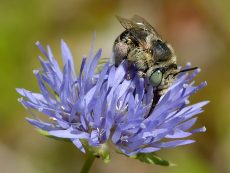
Nature lovers, rejoice: the little flower bee (pics) (Anthophora bimaculata) has been spotted in the North of Maastricht for the first time in 44 years. It was last seen in the Netherlands in the run up to the oil crisis of 1973.
On 18 June Kees Goudsmits spotted a female of the species (shown here) and a few days later on 23 June someone spotted a male in places where mines used to be, and they seem to be making their way North to places like Eindhoven.
This bee is so special, it doesn’t have a Wikipedia page in English (hint). Until the end of the 20th century, it was normal enough to see the little flower bee in the Eastern and Southern provinces. After WWII, the bee eventually disappeared, with the last one spotted in 1973 in the town of Tienray, Limburg.
(Link: naturetoday.com, Photo of Anthophora bimaculata by Ivar Leidus, some rights reserved)










